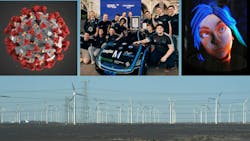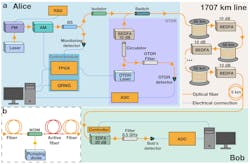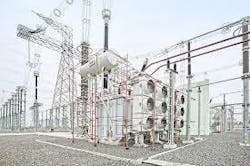The World’s Largest Electronic Development Projects and Accomplishments
- World’s Largest Onshore Wind Farm
- Most Powerful Supercomputer
- Longest Distance Traveled by an EV on a Single Charge
- Largest Distributed Computing Network
- World’s Largest Quantum Computer
- Largest Functional Smartphone
- Longest Quantum Key Distribution
- Largest Volumetric 3D Display
- Highest-Voltage AC Transformer
- NVIDIA ABCI-Q Supercomputer
- Experimental Advanced Superconducting Tokamak (EAST)
When it comes to pushing the boundaries of electronics, “small” often gets the spotlight as we tend to judge innovation by the latest mobile devices. However, some of the most impressive innovations in the world are massive.
From continent-spanning wind farms to quantum computers with thousands of qubits, engineers, scientists and researchers are building bigger, bolder systems that redefine what’s possible. This roundup looks at some of the largest electronics ever built and why they garner the title of “World’s Largest.”
World’s Largest Onshore Wind Farm
The Gansu Wind Farm Project, or Jiuquan Wind Power Base, is the world’s largest onshore wind farm project. It’s located in the desert lands of Gansu Province in northern China. The farm currently holds 7,000 wind turbines that generate 10 GW of electricity, which is expected to increase to 20 GW over the next few years when the project is completed. Enough electricity is generated to power 1 million homes, but that number is also expected to rise in the coming years.
Construction started in 2009 and continues in phases, with each new stage bringing in more turbines and more regional grid integration
Most Powerful Supercomputer
El Capitan currently sits at the top of the world's most powerful supercomputers and the planet's third-ever exascale machine after coming online at the end of 2024. Located at the Lawrence Livermore National Laboratory (LLNL) in California, the supercomputer is capable of performing more than 2.79 exaFLOPS.
According to LLNL, El Capitan uses a combined 11,039,616 CPU and GPU cores consisting of 43,808 AMD 4th Gen EPYC 24C 24-core CPUs (1,051,392 cores) and 43,808 AMD Instinct MI300A GPUs (9,988,224 cores). The MI300A provides 24 Zen4-based CPU cores and a CDNA3-based GPU integrated into a single organic package, along with 128 GB of HBM3 memory.
Longest Distance Traveled by an EV on a Single Charge
Engineering students from the Technical University of Munich hold the record for the most distance traveled by an electric vehicle (EV) on a single charge. Their muc022 Streamliner EV set a new distance record for an EV on a single charge, without solar-charging aids, of 1,599 miles (2,574 km) with a battery capacity of just 15.5 kWh, smaller than typical hybrids.
The vehicle’s shape is designed to help the car glide through the air, with a narrow leading edge and wheels tucked in underneath the body to reduce drag, which had a coefficient of just 0.159. The engineers replaced the EV’s original dual 440-W motor design, utilizing a single permanent-magnet design and a cutting-edge gallium-nitride (GaN) inverter. The muc022’s top speed? Just 26 mph (42 km/h).
Largest Distributed Computing Network
It may come as no surprise to some, but Folding@home takes the number one spot for the world’s largest distributed computing network. The distributed computing project tasks volunteers worldwide to use their PC power for protein folding, which helps scientists develop new therapeutics for a variety of diseases via simulating protein dynamics.
>>Also check out some of the world's smallest electronics
As a result of the COVID-19 pandemic, the system achieved a speed of approximately 1.22 exaFLOPS by late March 2020 and reached 2.43 exaFLOPS by April 12, 2020, making it the world's first exaFLOPS computing system. Since its launch back in October 2000, Folding@home has been utilized as an invaluable tool in the production of 226 scientific research papers.
World’s Largest Quantum Computer
The largest quantum computer currently online goes to IBM and its Condor platform, which uses the company’s WSE-3 chip. It’s the first to surpass the 1,000-qubit threshold, boasting a total of 1,121 qubits. A 2022 roadmap update from IBM still shows that they’re on track to produce a 4,000-qubit machine by the end of the year (2025).
IBM plans to interconnect multiple smaller quantum machines to form a single massive system, setting a new record for quantum-computing power. The roadmap outlines plans for a 1,386-qubit processor, known as Flamingo, to appear in 2025 and for a 4,158-qubit device, called Kookaburra, to make its debut along with it.
Largest Functional Smartphone
In 2024, YouTuber Arun Maini and Matthew Perks constructed a 6.74-ft.-tall version of an iPhone 15 Pro Max, setting the Guinness World Record for the largest smartphone replica. The massive iPhone functions just like its smaller cousin, which can send texts, make calls, use apps, and even take photos.
The pair designed the replica using an 88-in. OLED TV for the screen and built a custom aluminum frame to house all of the electronics, which includes cameras, speakers, a flashlight, and even buttons for app navigation and interaction. It also packs a functional charging port and USB cable.
Longest Quantum Key Distribution
Terra Quantum currently holds the world record for the longest quantum key distribution (QKD) at over 1,060 miles. According to the company, they accomplished that milestone by using standard optical fiber and optical amplifiers, leveraging multi-photon states along the transmission lines, which boosted the signal over long distances. They also deployed quantum decryption and encoding hardware at both the sender and receiver sites.
What’s more, the technique employed by Terra Quantum is compatible with existing telecommunication infrastructure and doesn't require special quantum repeaters.
Largest Volumetric 3D Display
The Voxon VX2-XL is the current crown holder for the world's largest volumetric 3D display. The platform creates holograms by projecting millions of points of light into a physical space, enabling viewers to see and interact with 3D models from any angle without the use of special glasses or headsets.
The display boasts a volume measuring 512 mm in diameter and 256 mm in height (about 20.5 × 10 in.), rendering interactive 3D volumetric holograms with up to 16 million color voxels. The technology is ideal for applications requiring genuine 3D spatial representations, such as medical imaging, education, and interactive installations.
Highest-Voltage AC Transformer
ABB holds the title of the world’s highest-voltage AC transformer: Its 1,200-kV ultra-high-voltage power transformer is designed to support India’s plans to build a 1,200-kV transmission system.
According to ABB, this 1.2-million-volt transformer makes it the highest alternating-current voltage level in the world.
The transformer is installed at the national test station at Bina, Madhya Pradesh, as part of a collaborative initiative by the country’s central transmission utility, Power Grid Corporation of India Limited (POWERGRID). The transformer, manufactured and tested at ABB’s facility in Vadodara, was designed to supplement the existing 400- and 800-kV transmission grid to meet increasing demand for electricity.
NVIDIA ABCI-Q Supercomputer
NVIDIA recently launched the Global Research and Development Center for Business by Quantum-AI Technology (G-QuAT), the world’s largest ABCI-Q research supercomputer dedicated to quantum computing. The massive supercomputer was delivered to Japan’s National Institute of Advanced Industrial Science and Technology (AIST), which is expected to help researchers mitigate key challenges in quantum computing, such as quantum error correction and algorithm development.
The ABCI-Q came equipped with 2,020 NVIDIA H100 GPUs interconnected by the company’s Quantum-2 InfiniBand networking platform. It also integrates several quantum-processing technologies, including a superconducting qubit processor from Fujitsu, a neutral atom quantum processor from QuEra, and a photonic processor from OptQC.
The platform is powered by NVIDIA’s CUDA-Q, an open-source hybrid framework designed to run large-scale quantum-computing applications.
Experimental Advanced Superconducting Tokamak (EAST)
According to the Academy, EAST and the resulting physics research will provide direct experience for ITER and CFETR (China Fusion Engineering Test Reactor), and it will ultimately contribute to the development of fusion energy.
The Artificial Sun takes advantage of a tokamak design, resembling a doughnut-shaped vacuum chamber, which is surrounded by magnets that control the superheated plasma. The magnets are made from superconducting materials, producing magnetic fields that stop the plasma from touching the chamber walls, which would cool the plasma. The test is designed to give the engineers insight into the possibility of using fusion energy.
End of the list… for now.
Whether it’s generating clean energy for millions or pushing computation into quantum heights, these record-setting projects and developments prove that going big is just as exciting as going small. As electronics continue to scale in every direction, it’s clear the future is going to be nothing short of monumental.
>>Also check out some of the world's smallest electronics
About the Author
Cabe Atwell
Technology Editor, Electronic Design
Cabe is a Technology Editor for Electronic Design.
Engineer, Machinist, Maker, Writer. A graduate Electrical Engineer actively plying his expertise in the industry and at his company, Gunhead. When not designing/building, he creates a steady torrent of projects and content in the media world. Many of his projects and articles are online at element14 & SolidSmack, industry-focused work at EETimes & EDN, and offbeat articles at Make Magazine. Currently, you can find him hosting webinars and contributing to Electronic Design and Machine Design.
Cabe is an electrical engineer, design consultant and author with 25 years’ experience. His most recent book is “Essential 555 IC: Design, Configure, and Create Clever Circuits”
Cabe writes the Engineering on Friday blog on Electronic Design.













